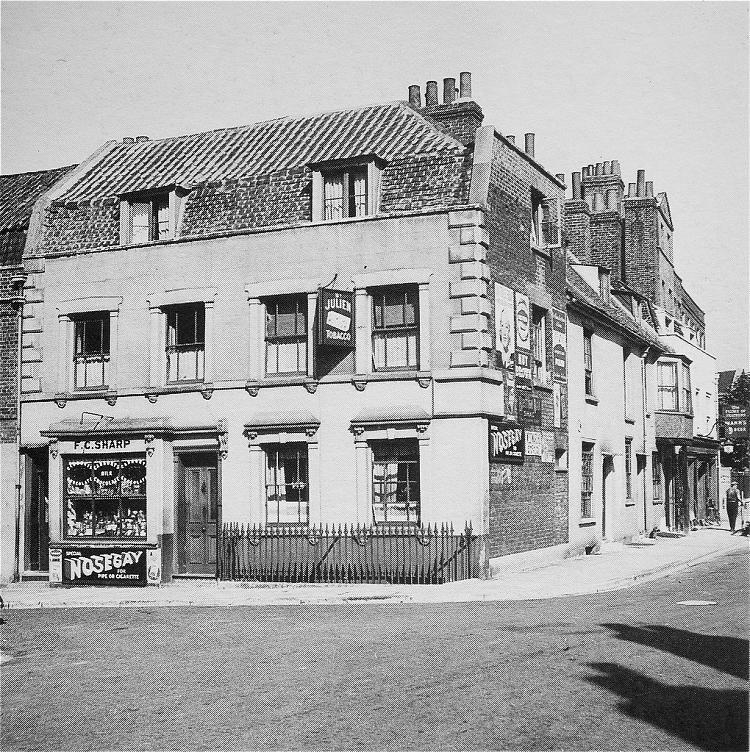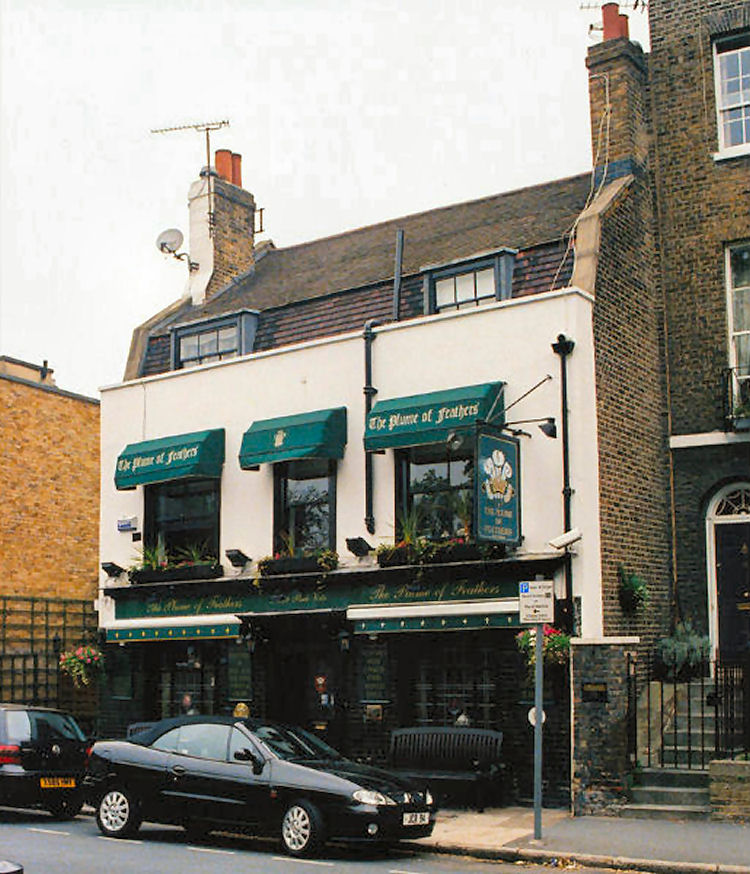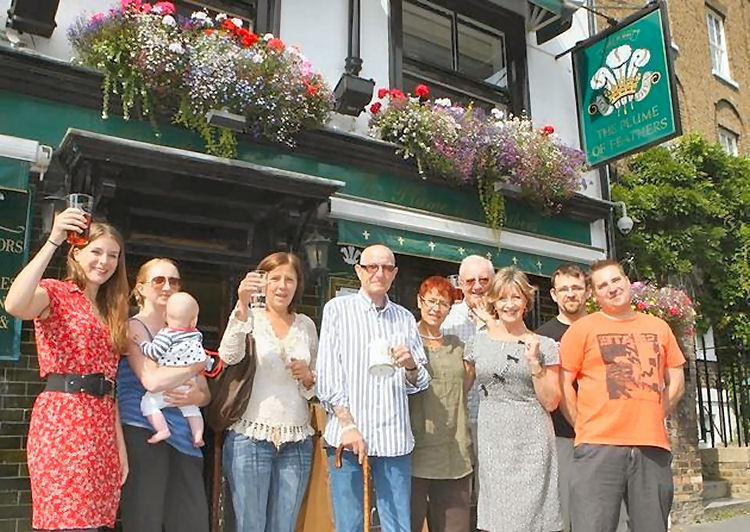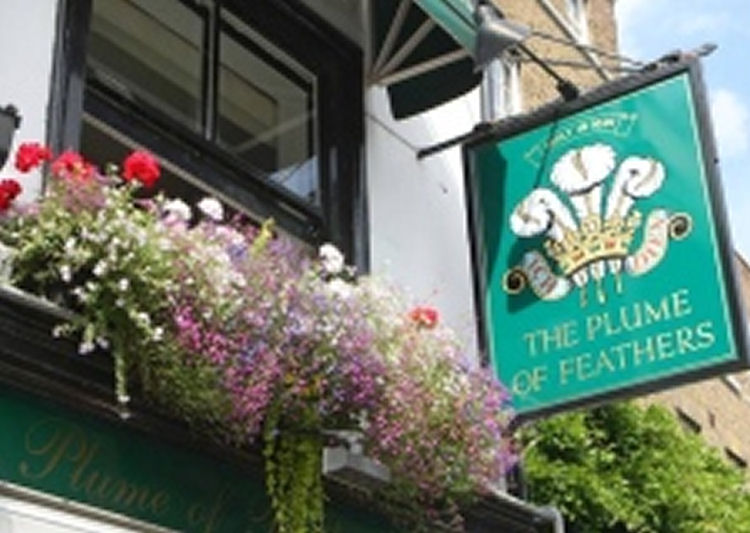|
19 Park Place (Park Wall 1866)(Mays Hill 1823 ) )
Greenwich
020 8858 1661
https://plumegreenwich.com/
https://whatpub.com/plume-of-feathers

Above photo, 1900, showing the pub extreme right. |

Photos taken from
http://www.flickr.com
by Matt Martin, in March 2007. |

Above photo, 2024. |

Above photo, 2024. |

Above photo, 2024. |

Above photo, 2024. |
This is said to be the oldest pub in Greenwich and can be dated back to
the 1600s. Steve Mortimore says the building was built in 1691 and was
called the "Prince of Wales" until 1726.
|
From the Borough of Greenwich Free Press, 23 August, 1856.
GREENWICH POLICE COURT - Monday.
Robbing the Board of Works.
Two men named Adams and Butler, in the employ of Mr. Samuel Hobbs,
of New Cross-road, Deptford, were brought up on remand before Mr.
Traill, charged with stealing about one hundred feet of York paving,
value 25s., and some mortar, value 2s. 6d., the property of the
District Board of Works, and William Preece, landlord of the "Plume
of Feathers," Park place, Greenwich, with feloniously receiving the
same, knowing it to have been stolen.
Mr. Bristow appeared for the defendant, Mr. Preece.
Mr. Charles Hughes, inspector of nuisances for the District Board,
having been sworn, deposed:— The Board of Works having ordered some new pavement to be relaid in Park
place, the old being worn out,
the same was ordered to be taken up and placed at the side of the
road, in order to be carted away at the earliest opportunity. For
the last fortnight, large quantities of stone had been missed, and
having my suspicions directed to Mr. Preece, on Saturday I proceeded
to his house in company with a constable. On entering his yard, I
found about fifty feet of the old paving. I told Mr. Preece the
property had been stolen. He said he had first been to the
prisoners, Adams and Butler and informed them that something was
broken in his yard, and wished to know if they could repair it. I
then asked Preece how much he had give for the stone, and he said as
much beer as the men could drink. I told him who the prisoners were.
He then said, he would give me or Mr. Hobbs, the contractor, any
amount rather than anything unpleasant should happen. I than gave
the men in charge, and afterwards proceeded to the house of Mrs.
Sylvan, in Park place, with a constable, and found some more of the
paving.
Mr. Hughes was then cross-examined by Mr. Bristow at some length,
but without at all shaking his evidence.
Mr. Samuel Hobbs was then called, and said:— I live in the New Cross
road, as a mason and pavior, and am the contractor to the Board of
Works. Adams and Butler are in my employ, the former having been
with me between five and six years, and always honest. They had no
authority whatever from me to dispose of any of the stone, and I
told them to that effect before they went to work. During the last
fortnight, nearly two hundred feet of old paving have been missed.
Mr. Bristow here put several questions to the witness.
Mrs. Sylvan having been sworn, deposed:— I am a single woman and
live in Park place. The prisoners, Adams and Butler, were laying
down stones in front of my house, and I went to them and asked if
they had any to dispose of, as I should like to purchase some. They
asked what I wanted with them, and I replied if they would come with
me to my house they could see. I agreed to give them six shillings
for the stones, and sixpence for some beer.
I then asked when I could have the stones, and they promised them in
three days. Before that time had expired, whilst I was absent from
home, they brought the stones to my house. The prisoners were both
together, and no other person was present.
Mr. Traill said as there was a large quantity of other stones
missing he should remand the prisoners.
The prisoners were remanded till Monday next, Preece being admitted
to bail in two sureties of £20 each, and his own recognizance of
£40.
|
|
From the Borough of Greenwich Free Press, 30 August, 1856.
GREENWICH POLICE COURT. Monday.
The Alleged Robbery on the Board of Works.
On Monday last, Sydney Adams and Thomas Buller were brought up for
final examination before Mr. Traill, charged with stealing one
hundred feet of York stone, the property of the Greenwich District
Board of Works. William Preece, landlord of the "Plume of Feathers,"
was also charged with receiving a portion of the same.
Preece was not present, but was defended by Mr. Bristow, who
accounted for his absence by serious illness.
There being no additional evidence, and the depositions already
taken having been read, Mr. Traill said the prisoners would be tried
under two indictments. The first for selling one portion of the
stone to Mrs. Sylvan; and the second for stealing and disposing of
the other portion to Mr. Preece. The magistrate added that he
thought Mr. Preece had not acted so cautiously as he ought to have
done.
Mr. Bristow concurred with the magistrate’s view, adding, that his
client did not altogether act with a "guilty knowledge" but with a
"guilty ignorance."
The prisoners, after the usual caution, deferred their defence until
their trial before a jury.
They were then fully committed for trial, bail being refused, and
the bail of Preece was enlarged for his appearance at the Sessions.
|
|
From the Borough of Greenwich Free Press, 6 September, 1856.
APPLICATIONS FOR SPIRIT LICENSES.
The following applications will be made for licenses at the Special
Sessions to be holden on the 25th day of September, inst.:—
Suspension of License,
Mr. Wm. Preece, "Plume of Feathers," Park place, Greenwich.
|
|
From the Borough of Greenwich Free Press, 20 September, 1856.
THE LATE PARISH ROBBERY
CENTRAL CRIMINAL COURT. Sept. 16. (before the recorder.)
Regina v, Adams and Others.
Our readers will recollect that the prisoners Adams and Butler were
committed from the Greenwich Police Court by Mr. Traill, upon a
charge of stealing the parish stone, and that Mr. Preece, the
landlord of the "Plume of Feathers," Park place, East Greenwich, was
held to bail, in order that the Board might prosecute him for
receiving the stone, knowing it to have been stolen, if they thought
fit. Several motions, pro and con, were made at the District Board
of Works upon the subject, when it was ultimately ordered that the
Clerk should prefer an indictment against Mr. Preece. Mr. Preece was
accordingly indicted before the Grand Jury, and a true bill was
found against him.
Mr. Sleigh, instructed by Mr. Edward W. James, the Clerk to the
Board, appeared to prosecute; Mr. Ribton, instructed by Mr. Thomas
Binns, appeared to defend Adams and Butler; and Mr. Serjeant Parry
(specially retained) and Mr. H. A. Simon, instructed by Mr. William
Bristow, appeared for Mr. Preece.
Upon the sitting of the Court, Mr. H. A. Simon said, in consequence
of a severe family affliction, Mr. Serjeant Parry (with whom he
appeared, and who had been specially retained), would be unable to
defend Mr. Preece, and he (Mr. Simon) therefore applied that his
Lordship might order the trial to be postponed until the next
Sessions. He was told by his friend Mr. Sleigh that under the
circumstances he should not object on the part of the prosecution,
and by his friend Mr. Ribton, who appeared for Adams and Butler,
that, as far as he (Mr. Ribton, was concerned, no opposition would
be made by him; he trusted, therefore, that his Lordship would
consent to the application.
Mr. Ribton said on behalf of Adams and Butler, for whom he appeared,
he could only say, that however much he would like to accommodate
the learned Serjeant, and under such circumstances, he conceived it
to be the duty of every one to do so, yet he should be obliged to
resist the application, unless his clients, who were in custody,
could be admitted to bail.
The Recorder:— The question is, whether the two men should be
detained in custody for five weeks, or the other man lose the
assistance of Mr. Serjeant Parry, who, as was well known, would be
unable to attend; he (the Recorder) sympathized deeply with the
learned Serjeant, and would look over the depositions and see if he
could admit the men in custody, and if so, there could then be no
objection to the case standing over.
Mr. Sleigh:— I have no objection, provided they give us good bail
and forty-eight hours notice.
Mr. Ribton:— Then we will say themselves in £80, and two sureties in
£40 each.
The Recorder:— There is now no difficulty; the case may stand over
until next Sessions.
|
|
From the Borough of Greenwich Free Press, 20 June, 1857.
PETTY SESSIONS. June 13th, 1857.
(Before Sir T. M. Wilson, Bart., Chairman ; Major Gosset, Captain
Grant, J. Sutton, Esq., and T. Lewin, Esq.)
TRANSFER OF LICENCES.
Greenwich.
"Plume of Feathers," Park-place, Susan Trench, deceased, to William
Boxhall Turpin.
|
|
Canterbury Journal, Kentish Times and Farmers' Gazette, Saturday 24 October 1891.
Found drowned in The Creek.
On Thursday last, W. J. Harris, Esq., one of the Coroner's for Kent,
held an inquest at the "Coal Exchange Inn," touching the death of
Edward Smith, age 58 years, whose body was found in the Creek on the
previous mourning. Until recently the deceased had kept the "Plume
of Feathers" public house at Greenwich, but, during the
fortnight
previous to his death, he had been staying at Faversham. He was a
native of this place, though he had not resided here for a long
period, and it is stated that he was a grandson of the late Mr. John
Smith, who, many years ago, occupied Perry Court.
Mr. F. Brett was chosen foreman of the jury, and the body, which was
lying at the rear of the premises, having been viewed, evidence was
taken as follows.
John Haywood, licensed victualler, Clifton Street, Frindsbury,
(pub not yet identified but supposed Ramsgate
area)
deposed that the deceased, Edward Smith, was his father-in-law, and
his age was 58. He was a licensed victualler and kept the "Plume of
Feathers," Greenwich. Witness last saw him alive 3 weeks ago, and
then understood him to say that he was going to Faversham to see
some friends.
Mr. John Gregory, waterman, of 9, Water Lane, Faversham, stated that
at 6 o'clock on Tuesday evening he saw the deceased leaning over the
rails of the bridge of the sluice gates. Witness passed the spot in
about an hour, and deceased was still there, though it rained very
hard. Witness spoke to him, but he did not reply, and witness
thought he belonged to a foreign ship lying in the Creek. Deceased
attempted to walk, but was in liquor and could not go straight.
Deceased went in the direction of the "Coal Exchange," and witness
did not see him afterwards.
Thomas Inge, labourer, employed at Messrs. Whittle and Co's wharf,
stated that about a quarter past six o'clock on Wednesday morning he
went along the wharf and saw something black in the Creek. On going
a little nearer he saw a hat beside it in the water. He fetched a
boat hook and secured it to the sleeve of the coat, and then found
it was the body of a man in the water. Witness called assistants and
the police were sent for. P.C. Acton came, and witness assisted in
getting the body out and bringing it to the "Coal Exchange." The man
was quite dead, and the body stiff and cold. There were no marks of
violence upon it. From the position of the body, witness was in
opinion that deceased must have fallen into the Creek at the Town
Wharf, overnight.
Police Constable Acton disposed that at 6:15 the previous morning he
was sent for and went to Messrs. Whittle and Co's wharf, where he
saw the deceased taken out of the water, and recognise the body as
that of a man who had been lodging at the "Recreation Tavern" for a
fortnight or more. He searched the body and found no marks of
violence upon it; he was of opinion that the body had been in the
water some hours. Witnessed took some money and keys from the
pockets, as well as two letters from deceased's daughters. Witness
had the body removed to the "Coal Exchange."
Inspector Fowle informed the Coroner as a matter of fact that the
deceased had lodged at the "Recreation Tavern" for a fortnight and
two days, and during the greater part of the time had been drinking
heavily.
The Coroner said there could be no sort of doubt that the cause of
death was suffocation by drowning, and the question for the jury to
decide was how deceased became drowned. There was the fact that he
was not sober at the time, and as the public had access to the wharf
it was very easy for him, in the state he was then, to have stepped
into the Creek without intending to do so. There was no evidence to
point to any intention of suicide.
Mr. Marsh, one of the jurymen, said deceased was at his eating house
a fortnight ago, and he acted in such a strange manner that he did
not believe he was accountable for his action.
The Coroner reminded the jury that deceased was upon the night in
question the worst for liquor, and had no control of his legs.
The Foreman observed that the night was very rough, and deceased
might of mistaken the turning to the wharf for the road over the
bridge.
The coroner remarked that there was a possibility of it being an
accident.
The jury returned an open verdict of "Found Drowned, and the Coroner
said he thought that was the best verdict to return under the
circumstances. |
|
From their web site accessed 25 March 2018.
Who would have thought that just a few generations ago the landlord of the Plume
of Feathers had a servant? But there she is, good old Elsie Bunyan, aged
29, in the 1911 Census. Name: Elsie May Bunyan. Sex: F. Relationship to
head: Servant. Occupation: Domestic. But times change and with it does Greenwich’s oldest pub. Today most
people would say the Plume of Feather ‘is a traditional boozer that is
nicely tucked away by the park’. That’s its charm and that’s the way us
locals like it. And it’s all thanks to Lord Romney. The pub was built in 1691, and was ideally situated on the busy Dover
Road as travellers left Greenwich. Coaches and carts would pass through
the gatehouse of the Queen’s House (possibly paying a toll there) and on
their left would be the perfect place to stop off before they headed
towards Kent. It’s likely that as well as being an inn, livestock, such
as cows and sheep, were also kept here. Samuel Travers map of 1695
describes the area as simply, ‘Freehold Lands in the Lordship of East
Greenwich and some Lands belonging to Lady Biddulph and Others within
the manor of West Comb.’ But as traffic increased Lord Romney, the Park Ranger at the time,
decided the original road was not big enough, so in 1699 he built a new
one (with some other men obviously) about 100 metres to the north. It’s
the Romney Road you still use today as you head towards Woolwich and
beyond. But for a few years the pub enjoyed being right there on the
‘main’ road. William III and Mary II were on throne when the pub first opened for
business. On 12 July William III’s troops defeated Irish and French
troops who were supporting the Catholic James II in the Battle of
Aughrim as part of the War of English Succession. At that time there was
no National Debt (it only came into effect in 1694) or even a Bank of
England (same year). The population of London as a whole was only
550-600,000. Greenwich Observatory was there (1695) – but what is now
the Old Royal Naval College was not because although Mary II
commissioned Christopher Wren to build the then Royal Hospital for
Seamen in 1692/3, it was only started in 1696. Clive Asslet, in his book Greenwich Millennium, describes the scene at
the time the pub was built: “Greenwich… had… been making every effort to
transform (itself) from impoverished fishing village into neat little
suburbs. At the beginning of the eighteenth century the Seamen’s
Hospital was edged by a surf of higgledy-piggledy timber-fronted houses
tumbling into mean streets and around odd little inlets and courts.” Evidence of the pub appears in the Greenwich Parish rate books in 1717
when John Isaacs (possibly the landlord) was paying rates of 10
shillings and 8d. Licensing records reveal that the pub was at that time
called the "Prince of Wales." Widow Jane Whitall took over the pub a few
years later and by 1726 had changed the name of the pub to The Plume of
Feathers. The Plume of Feathers is, of course, the heraldic badge of the Prince of
Wales. Although the use of three ostrich feathers can be traced back to
Edward, the Black Prince, who probably adopted it after it appeared at
the wedding of his parents, Edward III and Philippa of Hainault, by the
time of the Widow Whitall it was firmly in the preserve of the Prince of
Wales. Today the Plume insignia makes regular appearances in our lives
as it is used by numerous military regiments, the Welsh rugby team and
the Surrey County Cricket Club to name a few. And every time you use an
old-style two pence piece the Plume will be staring you in the face. The Whitall (or Wheatall) family – Jane, Stephen and Charles – were
landlords until 1770 when the licence was transferred to John Bendell,
with the rateable value for the pub at the time being £12. Just before
this Charles Whitall had bought a small cottage, part of the terrace to
the west side of the pub, and it’s likely the two properties were
knocked into one. When the cottages on the site of 21 Park Vista were
demolished in 1952 it was found that the beams ran through to the pub
(the previous end cottage that had been bought in 1770). It’s possible, like many pubs of today, that the Plume changed its name
from time to time. For instance, a sketch map of 1792 refers to it
simply as the Feathers Inn, with land to the east of it marked as
‘Tribunes reserved for the use of James Taylor Esq and servants of Park
Place’. Over the years the pub has been owned by various individuals,
the Beehive Brewery, the Hoare Brewery, the Watney Brewery, Truman’s
Brewery, Courage Supply Line, and Scottish & Newcastle. In 1884 Greenwich’s meridian was adopted by the world as the prime
meridian of the world (except the French, who continued to use the Paris
one until 1911) and in that moment the Plume of Feathers became the
first pub in the Eastern hemisphere (or at least one of them). And to
this day it continues to serve beer and food on its original site, which
now sits on the edge of the UNESCO Maritime Greenwich World Heritage
Site. The Rose family secured the licence of the Plume in 1980 and further
significant changes were made to the pub in 1994 when the kitchen was
extended, and the restaurant, which can seat 30 people, was built at the
back. Today the Plume of Feathers can host 150 people and, when our
infamous London weather allows, the garden another 50 people. Susan Rose
and son James have been independent landlords since 1999 when they
become free of the tie and were able to buy from various suppliers of
their choice. Today, this warm and friendly pub, adorned with original claygate
fireplace and features, enhanced by maritime relics and historical
paintings, continues to provide a feeling of being in a country pub
while being in one of the world busiest and greatest cities. What would servant Elsie Bunyon have made of it all we wonder? |
As the information is found or sent to me, including photographs, it will
be shown here.
Thanks for your co-operation.
|
From the
https://www.bexleytimes.co.uk By Marina Soteriou, 23 August 2011.
Greenwich pub goes for gold with their hanging baskets.

Landlady Sue Rose in the black and white checked dress with customers from the pub.
A pub was third time lucky after it won gold at a gardening competition.

The famous hanging baskets.
The Plume of Feathers in Park Vista, Greenwich, won the gold award for
the best hanging baskets and window boxes in this year’s Greenwich in
Bloom competition, after previously bagging the bronze and the silver.
Landlady Sue Rose, who has worked at the pub for 32 years, said: “We
were going for gold. The staff worked hard to win the prize, watering
the flowers religiously. They have surpassed themselves. Lots of
customers remark on the flowers and we are in a residential road so we
want to make the pub as pretty as possible as people on the road do a
lot to maintain their gardens.”
Mrs Rose, is due to collect her certificate a ceremony at Woolwich town
hall, after finding out about the win on August 13.
|
LICENSEE LIST
 WHITALL/WHEATALL Jane, Stephen & Charles 1726-1770
WHITALL/WHEATALL Jane, Stephen & Charles 1726-1770
BENDELL John 1770+
SMITH George 1775+
HOLMES Ezekiel 1777+
WADE Henry 1779+
BATCHELOR Francis 1783+
TURNER John 1785+
GARRETT John 1789+
NICHOLLS Thomas 1794+
LACKINGTON Mary 1823-34+
 
GEARY Thomas to Jan/1846 dec'd

GEARY Mary (widow) Jan/1846+

PREECE William 1847-56
TRENCH Susan dec'd to 13/June/1857
TURPIN William Boxhall 13/June/1857+
BARTON M Mrs 1862+
BRIEN George 1866-67+
GOSLIN James to May/1869
CRANE James Frederick Charles May/1869-Mar/72 dec'd (age 30 in 1871 ) )
CRANE Emma Elizabeth Mar/1872+
LEECH John 1874+
PORTER Charles 1881-82+ (age 30 in 1881 ) )
FIFIELD Joshua John 1889+
SMITH Edward to Oct/1891 dec'd (age 58 in 1891 ) )
LAWRENCE James 1896-1919+
LAWRENCE Herbert 1931+
PALMER Arthur Horace 1936-44+
???? 1962+
ROSE Jimmy 1978+
ROSE Susan 1980-99
ROSE Susan & James (son) 1999-2010+
https://pubwiki.co.uk/PlumeFeathers.shtml
 From the Pigot's Directory 1823 From the Pigot's Directory 1823
 From the Pigot's Directory 1832-33-34 From the Pigot's Directory 1832-33-34
 Census Census
 Kentish Mercury Kentish Mercury
|







